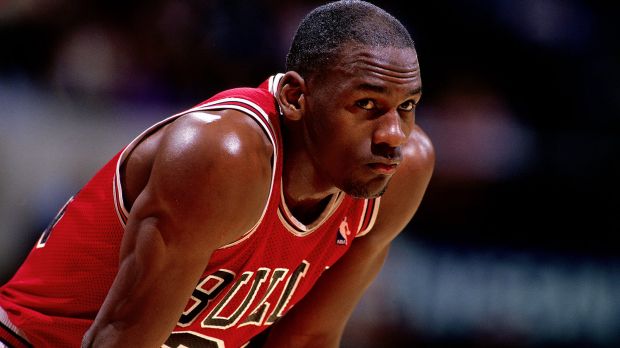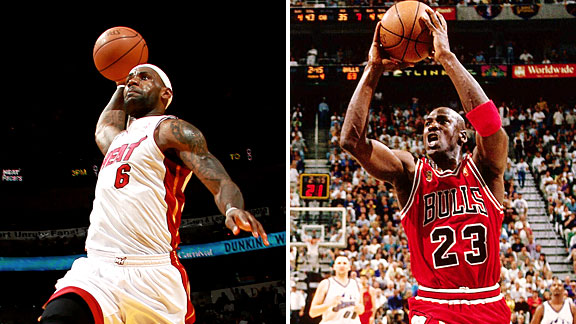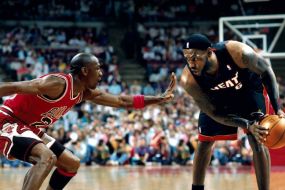
Corey Dick
I try to eliminate reliance on my gut by analyzing issues from an objective evidenced based perspective. My formal training is in law, but I have been a sports enthusiast since I was a young’un.
The Michael Jordan v. Lebron James debate has become an intriguing hot button issue over the past several years. Unfortunately, people on both sides of the argument tend to support their conclusions by providing a series of vague and unsubstantiated claims (e.g. “Lebron is a better all around player than Jordan was”). Indeed, an objective, careful analysis of each player’s career is required to arrive at the proper verdict. Well, the verdict is in, and Jordan wins.
Let's start the comparison between the two by recognizing their macro accomplishments and statistics. Jordan won 6 Finals and 6 Finals MVPs to Lebron’s 2 and 2 respectively. Jordan won 10 scoring titles to Lebron's 1. Jordan won a defensive player of the year award to Lebron's 0. Jordan lead the league in steals 3 times to Lebron's 0. Jordan was a 5 time league MVP to Lebron's 4.
In Jordan's best scoring season, he averaged 37.1 points per game. In Lebron's best scoring season, he averaged 30.0 points per game. The 1988-89 NBA season rendered Jordan's best rebound and assist totals, averaging 8.0 per game in each category. Lebron's best single season rebounds per game output was 7.9, and his best single season assists per game output was 8.6.

Or course, it can be challenging to delineate the meaning of these statistics when they are fragmented into their individual elements. Advanced analytics are useful to navigate through this process. Player Efficiency Rating (“PER”) measures a player’s dominance relative to the league average, which is standardized to 15 each year. Jordan tops Lebron in this metric, even when including Jordan’s years with the Wizards. Through age 30, Jordan had a career PER of 29.8; Lebron is 30 and has a career PER of 27.7. Win Shares per 48 Minutes (“WS/48”) calculates a player's contributions to his team’s wins. Through age 30, Jordan had a WS/48 of .273. Through age 30, Lebron has a WS/48 of .240. For greater context, this differential is similar to that between Hakeem Olajuwon and Horace Grant (WS/48 of .177 and .147 respectively).
Jordan’s decisive analytical advantage over Lebron is easy to fathom after careful study of their game film. As a scorer, Jordan had an incredibly diverse range of moves and shots to complement his near flawless footwork. As such, he was able to counterattack virtually any defensive tactic that his opposition presented. Lebron, conversely, relies on his speed and athleticism to earn open shots, and he hasn’t shown much ability to weave though and around traffic. Thus, it is easier for defenses to force the ball out of his hands.
The game film and statistical record also unequivocally demonstrate that Jordan was a decidedly more accurate jump shooter than Lebron. According to the Basketball Reference Shot Finder (“Shot Finder”), Lebron is a career 37% shooter on jump shots between 15-20 feet. Unfortunately, Shot Finder only tracks back to the early 2000s. We do know, however, that 40-year old Jordan shot over 42% on jumpers between 15-20 feet in the 2002-03 NBA season. It’s fair to assume that he shot a significantly higher percentage from that distance throughout his prime.

Lebron’s relatively inadequate jump shot wouldn’t translate well to Jordan’s era. In the 80s and 90s, teams ubiquitously stacked the paint with 3 to 5 defenders to stop the best perimeter scorers. Teams could get away with this strategy partly because the game had yet to evolve stretch fours and three point specialists to help stretch the court. For instance, John Paxson, Jordan’s prime years backcourt complement, never attempted more than 1.7 threes per game. By contrast, last season Kyrie Irving attempted 5.0 threes per game, and Kevin Love attempted 5.2 threes per game. The resulting court space opens up driving lanes for Lebron that Jordan didn’t have access to. Moreover, the illegal defense rule provided the only regulation designed to deter teams from packing the paint. The rule was fairly nebulous and difficult to enforce. Consequently, teams simply ignored it. Today, perimeter players, like Lebron, are the beneficiaries of a clear-cut defensive three seconds rule. Making matters more ominous for players like Jordan, hand-checking, now illegal, permitted defenders to guide their man away from the paint. In sum, perimeter players in the Jordan era needed to rely on their jump shots more than their contemporary counterparts.
Jordan’s greatness over Lebron is also salient with respect to their defensive abilities. Jordan had quicker hands and more adept anticipation skills than Lebron. This is evidenced by Jordan’s greater steal percentage (percent of opponent’s possessions that end with a steal by that player). As noted, Jordan lead the league in steals three times and won a defensive player of the year award. Lebron is not likely to accomplish either feat.
Lastly, Jordan’s killer instinct has gone unmatched since his retirement. NBA fans during the Jordan era knew that when the Bulls were playing and the game was on the line, Jordan would fearlessly take over and, more often than not, succeed in doing so. Lebron’s clutch time performances have been mercurial at best. Sometimes he will play aggressively down the stretch, whereas other times he will persistently pass off the game's most important possessions to his team's ancillary players. This style of play has not gone without consequence; Lebron’s fourth quarter passivity arguably cost the Heat the 2011 Finals. Throughout that series, Lebron averaged just 3 points per game in the final period.
When Lebron has taken the clutch shots, he has failed considerably more often than not. According to Shot Finder, Lebron is 37-122, 30.3%, in the regular season and 8-23, 34.7%, in the playoffs when shooting to tie or take the lead with 24 seconds or less in the fourth quarter or overtime and his team tied or trailing by 3 points or less. Jordan, in the playoffs was 9 of 18, 50%, under the same circumstances.
Even though Lebron’s career is far from over, it’s hard to imagine that his future play will undermine the analysis contained herein. Lebron has achieved a prodigious level of success, and he is indisputably one of the greatest players of all time. But he’s no Mike.
Recent Articles
-
NFL Confidence Pool Picks & Strategy 2024 - Week 18
 To say this has been a year of uncertainty is an understatement. So many injuries, coaching changes, player issues shaped…in Fantasy Football / NFL
To say this has been a year of uncertainty is an understatement. So many injuries, coaching changes, player issues shaped…in Fantasy Football / NFL -
NFL Confidence Pool Picks & Strategy 2024 - Week 17
 Christmas is indeed the time of giving. And this year, the NFL is giving us a double-header on Christmas Day…in Fantasy Football / NFL
Christmas is indeed the time of giving. And this year, the NFL is giving us a double-header on Christmas Day…in Fantasy Football / NFL -
NFL Confidence Pool Picks & Strategy 2024 - Week 16
 Normally, being just a few weeks away from the end of the season, playoff positions are solidified and we need…in Fantasy Football / NFL
Normally, being just a few weeks away from the end of the season, playoff positions are solidified and we need…in Fantasy Football / NFL -
NFL Confidence Pool Picks & Strategy 2024 - Week 15
 Finally! They’re done! We are heading into week 15 and FINALLY we are done with bye weeks! 16 games a…in Fantasy Football / NFL
Finally! They’re done! We are heading into week 15 and FINALLY we are done with bye weeks! 16 games a…in Fantasy Football / NFL
 Please wait...
Please wait...